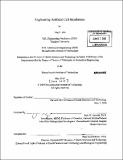| dc.contributor.advisor | Jack W. Szostak. | en_US |
| dc.contributor.author | Zhu, Ting F. (Ting Fredrick) | en_US |
| dc.contributor.other | Harvard University--MIT Division of Health Sciences and Technology. | en_US |
| dc.date.accessioned | 2010-09-02T17:27:02Z | |
| dc.date.available | 2010-09-02T17:27:02Z | |
| dc.date.copyright | 2010 | en_US |
| dc.date.issued | 2010 | en_US |
| dc.identifier.uri | http://hdl.handle.net/1721.1/58299 | |
| dc.description | Thesis (Ph. D.)--Harvard-MIT Division of Health Sciences and Technology, 2010. | en_US |
| dc.description | Cataloged from PDF version of thesis. | en_US |
| dc.description | Includes bibliographical references. | en_US |
| dc.description.abstract | Growth and division are essential biological processes of cellular life. A crucial question concerning the origin of cellular life is how primitive cells (protocells) lacking complex biological machinery could grow and divide. To address this question, we first developed an effective method for preparing large monodisperse (uniform-sized) vesicles through a combination of extrusion and large-pore dialysis. The development of this preparation method has led us to the discovery of a simple but efficient pathway for the growth and division of the membrane envelope of a model protocell: growth of a large multilamellar fatty acid vesicle after being fed with fatty acid micelles leads to a series of remarkable shape transformations, from an initially spherical state to a long thread-like vesicle; under modest shear forces, the thread-like vesicle divides into multiple daughter vesicles. We have also discovered a different pathway that allows the long thread-like vesicles to divide without relying on external forces. Furthermore, in the course of studying fatty acid vesicles, we have discovered a striking phenomenon: intense illumination causes dye-packed vesicles of a few microns in diameter to explode, rapidly and locally releasing the encapsulated contents. The photoactivated release of substances from exploding vesicles in a highly spatio-temporally controlled manner suggests potential applications of this phenomenon in many areas across disciplines. | en_US |
| dc.format.extent | vii, 177 p. | en_US |
| dc.language.iso | eng | en_US |
| dc.publisher | Massachusetts Institute of Technology | en_US |
| dc.rights | M.I.T. theses are protected by
copyright. They may be viewed from this source for any purpose, but
reproduction or distribution in any format is prohibited without written
permission. See provided URL for inquiries about permission. | en_US |
| dc.rights.uri | http://dspace.mit.edu/handle/1721.1/7582 | en_US |
| dc.subject | Harvard University--MIT Division of Health Sciences and Technology. | en_US |
| dc.title | Engineering artificial cell membranes by Ting F. Zhu. | en_US |
| dc.type | Thesis | en_US |
| dc.description.degree | Ph.D. | en_US |
| dc.contributor.department | Harvard University--MIT Division of Health Sciences and Technology | |
| dc.identifier.oclc | 656252865 | en_US |
